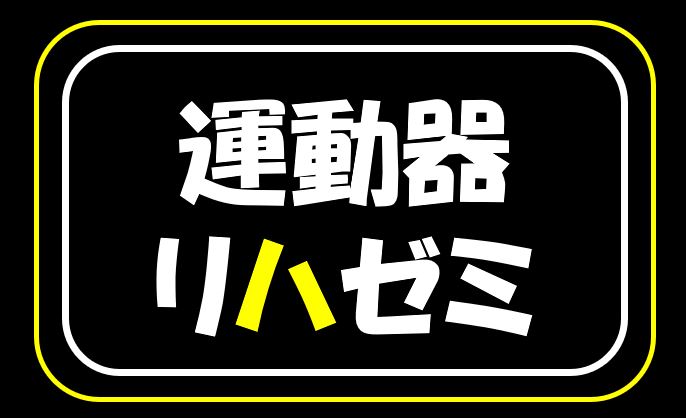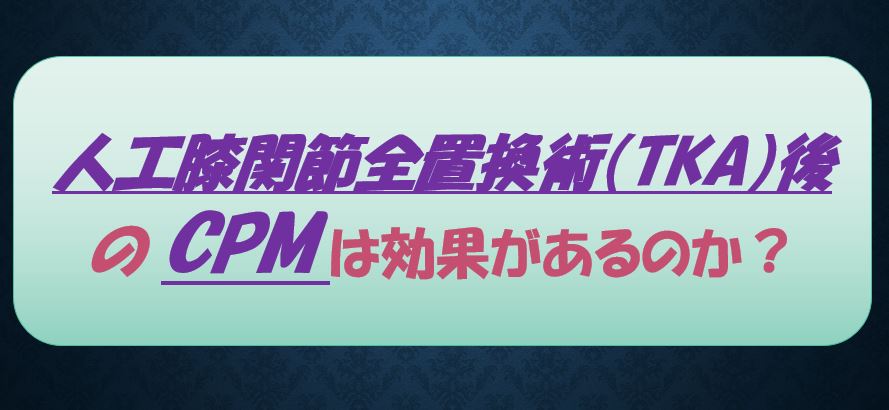こんにちは!
運動器専門のリハビリスタッフです!!
いつもお世話になります。
今回は、『人工膝関節全置換術(TKA)後のCPM(持続的他動運動)は効果があるのか?』
について解説させていただきます。
人工膝関節全置換術(TKA:Total Knee Arthroplasty)は変形性膝関節症や関節リウマチ、膝の骨壊死などの膝関節症によって、痛みや膝の曲げ伸ばしのやりにくさ(関節可動域制限)を改善するための手術です。
膝関節を人工膝関節に交換することで、痛みが軽減し、歩行や階段昇降などの動作がやりやすくなります。
なかでも高齢女性に多い変形性膝関節症からTKAに移行する割合が最も高いとされています。
人工膝関節全置換術(TKA:Total Knee Arthroplasty)の術後にリハビリ以外の時間に、病室などでCPM(持続的他動運動)といわれる機器によって、持続的に20~30分程度、膝の曲げ伸ばしが行われるものを使用している病院が多くあります。
そんな中、2020年に、人工膝関節全置換術(TKA:Total Knee Arthroplasty)後のCPM(持続的他動運動)は効果があるのかを検証した論文が海外で報告されております。
この論文の検証結果が気になるところですね。
◆論文紹介
Randomized Controlled Trial
Physiother Res Int (IF: 1.51; Q2)
. 2020 Oct;25(4):e1869.
doi: 10.1002/pri.1869. Epub 2020 Sep 28.
Impact of continuous passive motion on rehabilitation following total knee arthroplasty
人工膝関節全置換術後のリハビリテーションにおけるCPM(持続的他動運動)の影響
Nils Wirries 1, Marco Ezechieli 2, Kai Stimpel 3, Michael Skutek 1
Affiliations expand
- PMID: 32985036 DOI: 10.1002/pri.1869
Abstract
Background and purpose: There is an ongoing controversy in respect of the usage of continuous passive motion (CPM) following total knee arthroplasty (TKA). We analysed the impact of CPM on the early rehabilitation after TKA and the clinical outcome over the time.
概要
背景と目的:膝関節全置換術(TKA)後の持続的他動運動(CPM)の使用に関して、現在も論争が続いている。我々は、CPMがTKA後の早期リハビリテーションに与える影響と、長期にわたる臨床転帰を分析した。
Methods: Forty patients were prospectively randomized to postoperative protocols following TKA. Half of them (n = 20) received the standard manual therapy alone and the others (n = 20) were treated additionally with CPM. Identical implants were used in all patients. Passive range of movement (PROM) was noted. Patient satisfaction and knee function was evaluated using the Western Ontario and McMaster Universities Osteoarthritis Index (WOMAC) as well as the Knee Society Score (KSS) at time of discharge and 2 years postoperatively.
方法 40名の患者をTKA後の術後プロトコルにプロスペクティブに無作為に割り付けた。半数(n=20)は標準的な手技療法を単独で受け、他の半数(n=20)はCPM(持続的他動運動)を追加で受けた。すべての患者に同一のインプラントが使用された。他動可動域(PROM)が記録された。患者満足度と膝関節機能は、Western Ontario and McMaster Universities Osteoarthritis Index(WOMAC)とKnee Society Score(KSS)を用いて、退院時と術後2年目に評価された。
Results: The patients in the solitary manual therapy group (MT) showed preoperatively a 7.2° greater PROM (p = .03) with 5.4° higher flexion (p = .05). Analogously, the KSS presented with 42.7 points a higher score result compared to the CPM group with 35.9 points (p = .03). Although the preoperative ability with 105.2° for flexion and 97.2° for the PROM were in favour of the group without CPM (99.8° resp. 90.0°), at time of discharge the patients with CPM reached with 111.0° a significant higher flexion and with 109.0° a higher PROM (MT group: 107.0° resp. 103.5°) (p = .04/.02). At 2 years follow-up both scores (WOMAC/KSS) and function (extension, flexion and PROM) were balanced (p > .05). Patella resurfacing showed no impact on the clinical results at discharge or at time of last follow-up (p > .05).
結果 手技療法群(MT)では、術前にPROM(他動関節可動域)が7.2°大きく(p=0.03)、屈曲が5.4°大きく(p=0.05)なっていることが示された。同様に、KSSは42.7点と、CPM(持続的他動運動)群の35.9点に比べ高いスコアを示した(p = 0.03)。術前の屈曲は105.2°、PROMは97.2°とCPMなしの群に軍配が上がったが(99.8°、90.0°)、退院時にはCPMあり群は屈曲111.0°、PROM 109.0°と有意に高く(MT群 107.0°、103.5%)(p = .04/.02 )、CPMあり群はCPMなし群に軍配が上がった(p = .04/.02)。2年後の追跡調査では、スコア(WOMAC/KSS)と機能(伸展、屈曲、PROM)の両方が均衡していた(p>.05)。膝蓋骨表面置換術は、退院時および最終フォローアップ時の臨床結果に影響を与えなかった(p > 0.05)。
◆論文の結論
Discussion: Although the addition of CPM did significantly improve knee flexion in the early postoperative stage, the difference might not represent a clinical relevance. Further, there were no notable effects on long-term clinical and functional results following TKA, so the routine application of CPM in the above stated setting might be ceased.
考察 CPM(持続的他動運動)の追加により術後早期の膝関節屈曲は有意に改善されたが、その差は臨床的な意味を持たない可能性がある。また、TKA後の長期的な臨床的・機能的結果に対する顕著な効果は認められなかったため、上記のような環境下でのCPMのルーチン的な使用は中止される可能性がある。
◆まとめ
上記論文ではTKA(人工膝関節全置換術)後の患者40名を標準的な手技療法を単独で受けた手術療法群とCPM(持続的他動運動)群20に振り分けCPMの効果について検証しております。
退院時と術後2年目に他動関節可動域、患者満足度と膝関節機能はWestern Ontario and McMaster Universities Osteoarthritis Index(WOMAC)とKnee Society Score(KSS)を用いて評価しております。
結果として、退院時の他動関節可動域はCPM群が屈曲111.0°、手術療法群では109.0°とCPM群が有意に高かったですが、ごくわずかの差だったようです。
また、2年後の評価ではWOMAC、KSS)、関節可動域は均衡していたようです。
上記論文の結果を踏まえると、
TKA(人工膝関節全置換術)後にCPM(持続的他動運動)を追加することで退院時の早期段階ではわずかに屈曲可動域が向上するが、長期成績では特に臨床成績は変わらないということがわかりました。
CPMは術後患者の負担が大きく、痛くてつらいという訴えが多い割には効果は乏しいようです。
今回は、『『人工膝関節全置換術(TKA)後のCPM(持続的他動運動)は効果があるのか?』
について解説させていただきました。



